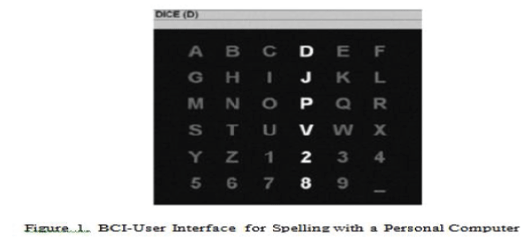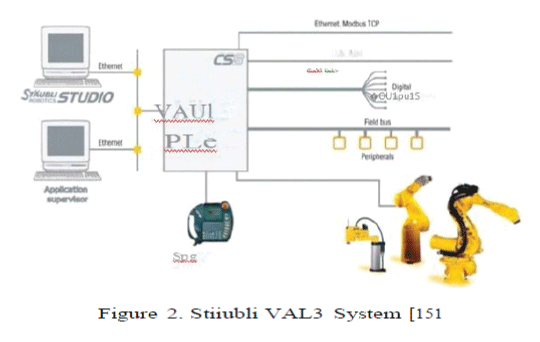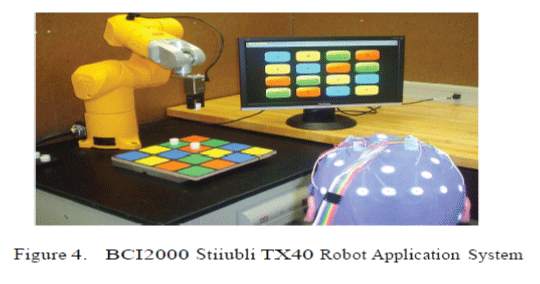Keywords
|
| Biomedical Robot Application, Brain-Computer Interface |
INTRODUCTION
|
| A Brain-Computer Interface (BCI) is a system that allows individuals with severe neuromuscular disorders to communicate and control devices using their brain waves. It has been demonstrated that a noninvasive scalp-recorded ElectroEncephaloGraphy (EEG) based BCI paradigm can be used by a disabled individual for long-term, reliable control of a personal computer [3]. This BCI paradigm allows users to select from a set of symbols presented in a flashing visual matrix by classifying the resulting evoked brain responses. The same BCI paradigm and techniques used for the aforementioned demonstration can be straightforwardly implemented to generate high-level commands for controlling a robotic manipulator in three dimensions according to user intent. The robot application is envisioned to provide superior dimensional control over alternative BCI techniques, as well as provide a wider variety of practical functions for performing everyday tasks. This paper describes an initial step toward providing disabled individuals a new level of autonomy for performing everyday tasks, hence improving their quality of life. The objective of the initial experiment is to demonstrate that an EEG-based BCI can provide accurate and reliable high-level control of a robotic manipulator. A novel man-machine interface between the human rain and the robotic manipulator is developed and insight into the practicality of a BCI operated assistive manipulation device is explored with initial experimentation developed. |
BACKGROUND
|
| Conventional prosthetic and assistive devices require some minimum level of voluntary muscle control and are not appropriate for people in a severely disabled condition. Brain signals such as scalp-recorded EEG can provide alternate, non-muscular channels for communication and control. A BCI exploits these brain signals for communication directly from the brain to an output device, independent of peripheral nerves and muscles [1-3]. BCI may be used to develop new assistive communication and control technology that will allow individuals with severe neuromuscular disabilities to express their wishes to caregivers, interact with their environment, operate a neuroprosthesis, operate a personal computer, and in this case control a precision modem robotic manipulator. Modem life-support technology can significantly extend the life spans of these individuals, potentially prolonging the personal, social, and economic burdens. The hope is that the merging of BCI and robotics technology will greatly improve the quality of life for individuals and relieve some of the associated burdens for care giving. Robotic manipulators have been widely used over the past few decades. Early applications include material handling and industrial automation while more recent and more advanced applications include surgery. Various control strategies have been developed over the decades with some of these applied to both single manipulator robots and to robots with multiple manipulators. The need for dual-arm robots has been recognized in physical systems implementations among the control strategies [4-12]. Cooperative manipulation is an important enhancement to robotic capabilities as a dual-arm robot is able to perform more complex tasks, manipulate multiple objects, and spans a greater workspace as would be useful in care giving. Personal robots, including assistive devices, are surveyed in [13]. |
METHOD FOR INTERFACE AND ROBOT APPLICATION
|
| In this application, the control of Staubli TX40 robots is achieved by implementation of a BCI by interpretation of low voltage EEG brain signals interfaced using BCI2000 software. The brain waves are acquired directly from the scalp using a cap with metallic electrodes as shown in Figure 4. Predictable transient amplitude deflections, known as P300 evoked potentials, are generated in the EEG as the BCI user concentrates on one of the flashing light command icons on the monitor. The P300 signals are captured and processed by the BCI2000 software. The signals are obtained by the middleware that performs as a buffer system for the input signals to the robot. The middleware layer acts as a buffer for the control commands and as a translation layer to the robot. The signals are relayed to the robot controller via socket communication using TCP/IP protocol over a network. Once the controller receives the signals, the VAL3 program for the robot interprets the signals and the manipulator arm moves accordingly. |
BCI2000
|
| BCI2000 [14] is a general purpose BCI stimulus presentation and biosignal recording package that includes a software application called the P3Speller. A sample 6x6 P3Speller alphanumeric symbol matrix is shown in Figure 1. The user focuses on the desired symbol while the rows and columns flash in a randomized pattern. A P300 response should be elicited when the column or row containing the desired symbol is flashed. After a predetermined sequence of flashes, the desired symbol is predicted by a userspecific P300 classifier in BCI2000 and online feedback is provided to the user. The predicted symbol can also be used to represent a control command for an assistive device, analogous to a conventional keyboard input. |
Stiiubli TX40 Robots and VAL3 Software
|
| VAL3 is a software product [15] for robot application development. This programming language is adapted to the unique requirements of robotics in order to run applications in a simplified and unified manner. The VAL3 software is used to develop an applications for robots, in this case StaubIi TX 40 robots [15] to accomplish data exchange, input/output, program control, event and error logging, control of operating modes and cycle restarts, and optimum behavior on the trajectories. Figure 2 illustrates the concept of VAL3 being central to the robot application while allowing communication to other computers. The interface of the robot application to the middleware discussed above is programmed using 10 streams and sockets available in the VAL3 software library. The Staubli TX40 robotic arms are six-degrees of freedom (six-axis robots) that are capable of fully emulating the human arms thus making them a suitable choice when performing common care-taking tasks. |
Middleware forInterface ofBCI2000 to theStiiubli TX40
|
| This section briefly discusses the middleware software layer [16] that facilitates communication between the P3Speller application of the BCI2000 software package and the Staubli VAL3 application that is controlling a Staubli TX40 industrial robot. The middleware buffers control commands produced by BCI2000 for consumption by the TX40 robot communications. The middleware also addresses the differences between the arbitrary control command format produced by BCI2000 and the format expected by the VAL3 robot software. The middleware uses a first-in first-out (FIFO) queue structure that accounts for both overproduction of commands from the BCI2000 and over-consumption of commands by the robot VAL3 software. Communications among P3Speller, the VAL3 application, and the middleware layerimplementation take place over Ethernet using TCPIIP input/output streams. As illustrated in Figure 3 BCI2000 with the P3Speller application is resident on a personal computer and communicates with the robot via TCP/IP. |
DESCRIPTION AND RESULT OF INITIAL EARLY STAGE EXPERIMENT
|
| In the previous section, the components of the system are described. These are the BCI2000 system including the P3Speller application, the middleware, and the robot consisting of the Staubli TX40 robots and the bundled VAL3 software to communicate with and control the manipulators. The P3Speller modifications enable it to establish a network connection to the middleware layer, generate control commands, and send the control commands to the middleware via the network connection. The run-time activity of the P3Speller changes is transparent to the P3Speller end-user. |
| The early stage, proof-of-principle application developed is the pick-and-place of cylindrical objects (representing target objects such as common house hold items) based on user input of P300 signals generated from the BCI2000 software. A Staubli TX40 robotic arm is first programmed to interact in a workspace environment that maps to the computer screen, the BCI2000 software grid in this case a 4x4 color-based array. Control of the robot using the P300 signals is implemented so that the robot picks and places the blocks based on the screen position that the human user is focusing. Horizontal and vertical rows are flashed to modulate the brain-wave signal read by the BCI2000. The application is to stack the objects through the EEG signals obtained using the BCI2000. A logic algorithm is added to the robotic application to avoid the possibility of over stacking the objects. Logic tracking using VAL3 is used to maintain knowledge of the object locations with respect to the robot arm [17-18]. |
| The robot application of a brain computer interface to the Staubli TX40 robots in its early stages is shown in Figure 4. The user is wearing a EEG cap that transmits signals to the BCI2000. P300 signals are generated as the patient concentrates on one of the flashing light command icons on the monitor. The P300 signals generated by the BCI2000 represent grid locations in the colored 4x4 grid. The user simply concentrates on the location of the grid that he or she desires to either pick or place an object. This is done without any use of voice or muscle interaction from the user. The intent of the user is generated strictly from the brain-wave readings. The middleware communicates the intent of the user to the robot. The robot keeps track of the pick and place sequencing, but has no a priori knowledge of the goals of the user, however the grid locations in the 4x4 array are pretaught points stored in array of target positions. The development and customization of the P3Speller application, communications and middleware, and integration with the StaubIi TX40 robot application comprise a unique early stage application as shown in Figure 4. |
| The robot early stage application is successfully tested and implemented to pick and place objects using the brain wave generated P300 signals captured from the BCI2000. The user picks a starting and ending destination for the block by concentrating on the screen and the robot successfully moves the objects to the desired task goals accordingly. The tracking algorithm also allows for the objects to be stacked if a locations is previously occupied by another object. |
CONCLUSION AND FUTURE WORK
|
| Ongoing stages of development include extending the interface with symbols that represent spatial grid locations and high-level robotic manipulator commands. The contents of the matrix can be anything from alphanumeric characters mimicking a standard keyboard, to symbols representing specific device commands or application macros. Replacement of the alphanumeric characters beyond a colored grid with symbols that represent spatial grid locations and high-level robotic manipulator commands to achieve more complex tasks including dual-ann robotic operations is being developed using two of the Staubli TX40 robots. Addition of other sensor modalities for the robot, such as machine vision, to interact with a disabled user and the robot is also within the scope of development activity. In the early stages of this BCI-robot application development, the user chooses the desired action simply by thinking and concentrating on the modulated grid, the command is sent, and the robot perfonns a simple pick-and-place stacking task. This fundamental network of processes can be expanded and improved to accommodate various advanced robot applications that can be used to help severely disabled people gain independence in their lives. |
ACKNOWLEDGEMENTS
|
| This work is partially supported under award #0904435 from the National Science Foundation Division of Infonnation and Intelligent Systems. This work is also partially supported under the auspices of Florida's First Coast Manufacturing Innovation Partnership, sponsored by the Partnerships for Innovation Program of the National Science Foundation, award #0438582. |
| |
Figures at a glance
|
 |
 |
 |
| Figure 1 |
Figure 2 |
Figure 3 |
|
| |
References
|
- D. M. Taylor, S. I. Tillery, and A. B. Schwartz, "Direct Cortical Control of 3D Neuroprosthetic Devices, " Science, 296(5574):1829-1832, Jun 2002.
- R. Wolpaw, N. Birbaumer, D. 1. McFarland, G. Pfurtscheller, and T. M. Vaughan, "Braincomputer Interfaces for Communication and Control, " Clinical Neurophysiology, 113(6):767-791, Jun 2002.
- T. M. Vaughan, D. 1. McFarland, G. Schalk, W. A. Sarnacki, D. 1. Krusienski, E. W. Sellers, and J. R. Wolpaw, "The Wadsworth BCI Research and Development Program: At Home with BCI, " IEEE Transactions Neural System Rehabilitation Engineering, 14(2):229-233, Jun 2006.
- H. Lipkin and 1. Duffy, "Hybrid Twist and Wrench Control for a Robotic Manipulator, " Transactions ASME Journal Mechanisms, Transmission, and Automation Design, 110:138-144, 1988.
- S. Hayati, "Hybrid Position/Force control of Multi-arm Cooperating Robots, " Proceedings IEEE 6. International Conference on Robotics and Automation, pp. 82-89, 1986.
- T. Tam, A. Bejczy, and X. Yun, "Design of Dynamic Control of Two Cooperating Robot Arms: Closed Chain Formulation, " Proceedings IEEE International Conference on Robotics and Automation, pp. 7-13, 1987.
- M. Uchiyama and P. Dauchez, "A Symmetric Hybrid PositionlForce Control Scheme for the Coordination of Two Robots, " Proceedings IEEE International Conference on Robotics and Automation, pp. 350-356, 1988.
- D. Cox and D. Tesar, "Characterization of Robotic Operations for Dual-arm Robots with Cooperating Manipulators. " Robotics, Spatial Mechanisms, and Mechanical Systems: Proceedings 22nd Biennial Mechanisms Conference, pp. 445-453, 1992.
- D. Cox and D. Tesar, "Development System Environment for Dual-arm Robotic Operations, "Robotics and Manufacturing - Recent Trends in Research, Education, and Applications, 5:61-66, 1994.
- D. Cox, "Mock-up of Hazardous Material Handling Tasks using a Dual-arm Robotic System, " Robotics, Automation, Control, and Manufacturing: Trends, Principles, and Applications, 8th International Symposium on Robotics and Applications 14:324-331, 2002.
- D. Cox, "A Geometric Control Algebra for Cooperative Manipulation, " Robotics - Trends, Principles, and Applications: 10th International Symposium on Robotics and Applications, 15:259- 264, 2004.
- P. Dario, E. Guglielmelli, and C. Laschi "Humonoids and Personal Robots, ". Journal of Robotic Systems, 18(12):673-690, 2001.
- G. Schalk, D. 1. McFarland, T. Hinterberger, N. Birbaumer, and 1. R. Wolpaw, "BCI2000: a general purpose brain computer interface (BCI) system, " IEEE Trans Biomed Eng, 51(6):1034-1043, Jun 2004.
- http://www.staubli.com/.
- Henderson, "A Design For a Middleware Communications Layer Between an Industrial Robotic Arm and the BCI2000 Software Package, " 23rd Annual Florida Conference for Recent Advances in Robotics (FCRAR), Jacksonville, May 2010.
- N. Waytowich, "Development of Staubli Robotic Manipulator Arm Programming to Receive BCI2000 Input Signals for Brainwave Control, " 23rd Annual Florida Conference for Recent Advances in Robotics (FCRAR),Jacksonville, May 2010.
- N. Waytowich and G. Kudry, "Development of Several Applications using StaubIi Robotic Manipulator and BCI2000, " 23rd Annual Florida Conference for Recent Advances in Robotics (FCRAR), Jacksonville, May 2010.
|